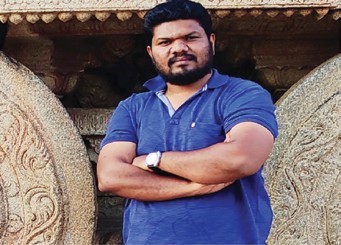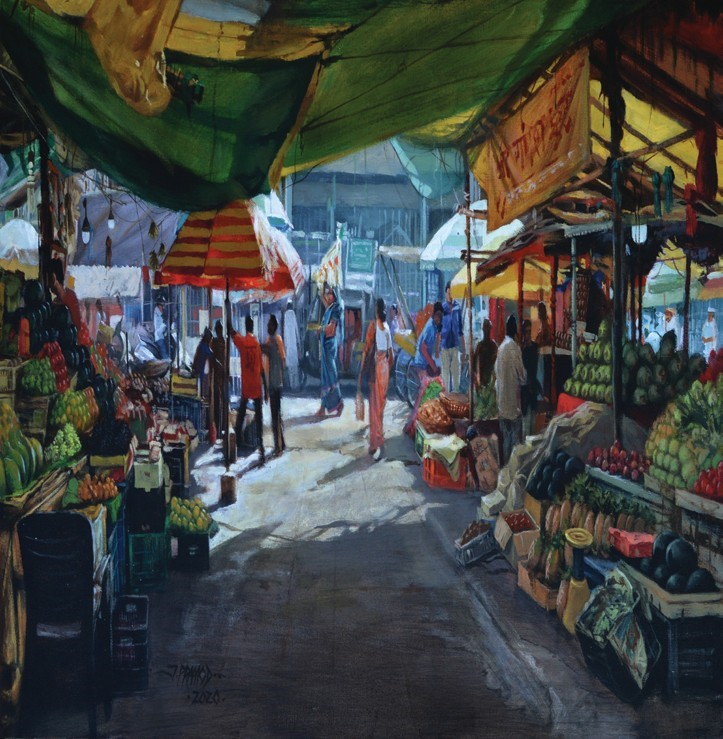“Art is the most appropriate way to reach salvation”
 Pramod Bhaginath
Pramod Bhaginath
Pramod Jagtap Bhaginath (35), is an Ahmednagar-based award-winning artist, presently into portraits and landscapes. An art teacher, he writes poems, has written and recorded some songs, likes to write plays, has directed a short film ‘Zing’ and done art direction for many plays.
Here he talks about art and life in a candid conversation with A. Radhakrishnan.
How did your journey begin?
Born and brought up in Ahmednagar city, in a police officer’s family with no artistic background, I used to take interest in sign and election board painting. I did my ATD (Art Teacher Diploma) and Government Diploma in Arts from Rachana Kala Mahavidyalaya, Dip.A. Ed from the J.J. School of Arts and a Diploma in Animation from IIACR, Pune.
How much has Mother Nature influenced you?
We lived in a remote part of the main city, which was less populated and where farmlands would start. So, I enjoyed both urban and rural landscapes as a child. While I played games like cricket and football in school; at home I used to go to the adjacent fields to pick sugarcane, groundnuts and also go for swimming.
The taste of sour green mangoes still lingers. I have sweet memories of sleeping in the dark shadow of a tree. Later, we shifted to a new house, and when I visited the fields after sometime, I saw there were buildings all over the area. “Is it the same mango farm where we used to play?” I wondered.
I missed the place the fields where I played. I thought, how nice it would be if I could paint a picture of my favorite place in my own colours? The change in landscape propelled me towards painting. Hence the dark shadows are always a major part of my paintings.
I was attracted towards landscapes. The pleasure you derive painting close to Nature can’t be experienced in an air-conditioned studio. The inspiration and energy she exudes is unmatched. Every single thing, single place has its own vibes and parameters but an artist should be able to capture the mood of the place. If a painter has painted an evening scene, it should look like evening. Similarly if it is afternoon it should look like afternoon.
How important is colour, light and space in a painting? And solitude?
All three are complementary. Without light, a painting is lifeless. Colours give life and meaning to a painting. E.g., you can convey intense emotions by just filling up a circle with red colour on a canvas. If you fill the same circle with blue it emotes certain calmness and pleasantness…the colour green conveys another emotion, so on and so forth. Space division is an important element of a painting which a good artist will always use it to enhance his/her work.
I enjoy the company of people while painting, as it energises me. I don’t look for solitude.
Do you need to show light and dark in a landscape, including the trees? Should you always add clouds in a landscape?
Painting cannot be done without bringing in the light and dark elements; you can only adjust the ratio between them depending upon what and when you are painting, be it trees, houses, mountains, water, etc.
More clouds give your painting a larger perspective and more space for the land and other scenery makes it mysterious. Dark colours add depth to a painting and can be used to create shadows.
Do you teach landscape painting? Any particular method you use for teaching? Do you use photos and photoshop filters?
It is difficult to summarise an exact teaching method. There are various steps from basics to advance. Generally, though landscape is not a part of syllabus of any art curriculum, it does include outlines and perceptions from portraits, still-life and nature drawing. Students need to understand simple and basic outlines of Nature first. To achieve this, I start teaching with outdoor sketching.
 A vegetable and fruit market in acrylic medium from his Breathing Lights series
A vegetable and fruit market in acrylic medium from his Breathing Lights series
Depth is another important aspect of a painting which is created with lines, figures and colours. Once, I teach basic techniques, I let my students work freely. Realism is an inherent part of landscapes and choosing a medium – watercolours, oil, acrylic, charcoal, pastels, pencils etc., is an individual choice once you learn and master various techniques.
Yes, I use photos for reference, but without filters.
Who has influenced you in portrait and landscape painting?
Growing up in the company of a great painter like A.G. Shekatkar taught me a lot. In college, we students mostly painted with water colours. He would give us a demo and would be very upset to see dried up colours in our paint boxes. He would say a colour box should always be “wet”. We misconstrued his words and would pour water on the colours to make it wet.
When he saw us doing that he explained: “What I meant is you should be painting regularly, i.e. every day. Then you don’t need to add water to your box.” That lesson of ‘continuous working’ has remained with me throughout my life.
My work is not influenced specifically by any one artist, but is a combination of what I learn from all.
What’s the difference between a landscape, a genre painting and an environmental or land art?
Landscapes earlier considered paintings of Nature, have evolved over years and are now categorised under various genres like seascapes, moonscapes, mountainscapes, cityscapes, nightscapes, etc.
Different painting styles from different states and regions have also evolved into various genres over — e.g., Miniature, Madhubani, Warli, Gond, etc. In western culture, genre painting is termed as ‘hyper realistic’ art style that includes subjects like banquets, assemblies, workers and day to day life of people.
 Pearl in hand (acrylic)
Pearl in hand (acrylic)
In last 50-60 years, numerous artists have started supporting environmental causes, and use massive land fields and natural objects to create huge art pieces which are called land art.
How important is travel for landscape painters?
Very important. Experiencing the actual places adds various perspectives to your painting. Though a lot of painters paint with the help of photographs, it does not help incorporate the feel of the place.
Define portrait, still life painting and portraiture?
I think the major difference between portrait and portraiture is that the former is devoid of emotions and the latter brings out emotions.
Portraits are mostly done by artists on demand from customers for commercial reasons. On the other hand, when an artist paints a model inculcating all his/her emotional features and personal traits, it is called portraiture.
Still life is painting inanimate objects whether they are manmade or natural.
What size should a portrait be? How to avoid a portrait look like a photo? Can the artist correct flaws or depict a person exactly as they are?
Paintings should not be restricted to sizes. A portrait not only includes faces or figures, but can use various objects too. Done in various mediums, which have their own characteristics, artists have to master the skills involved. Every painter develops his own style like patch work, flow work, outlining etc., which always helps a painting to be different from a photograph.
The purpose behind a portrait decides whether an artist can overlook the flaws or paint the model as they look. Only an ace painter can achieve the likeness.
What about self-portrait?
An artist starts knowing himself when he starts doing self-portraits, and gains self-confidence. Some artists have done it in a depressed state and yet their paintings have become immortal, for e.g Vincent Van Gogh.
What are the various styles of portrait painting?
There is realism, surrealism, impressionism, photorealism, expressionism, cubism, divisionism, etc., which have become popular. Portraits can also be classified by colouring methods and mediums like water colours, oil colours, opaque, fresco, sfumato, ink wash, etc.
Explain your foray into nude life painting? What does it entail?
It is a very sensitive subject in our country. A lot of painters do not consider it as nudity, but an important form of anatomy art where you can highlight the deepest emotions of a human being.
I have attended several private sessions for studying nudes. Here this art form is only taught at Sir J.J. School of Arts. Lot of people study it through books or photographs, but the real time model experience is unmatched.
Have you done any series of portraits and landscapes? Exhibitions?
Art is a journey of different stages. Presently I am into profile and nature painting, as also subjective paintings in portraits. Earlier, I have done a series featuring historical temples, including Hampi and Varanasi. I am also working on old buildings in both the city as well as village where people’s memories linger. The light falling on the dilapidated buildings illuminates every moment of their lives and feels alive. Hence, I have named the series, ‘Breathing Lights’.
I have done group shows at art galleries in Ahmednagar, Pune and also at various art festivals.
